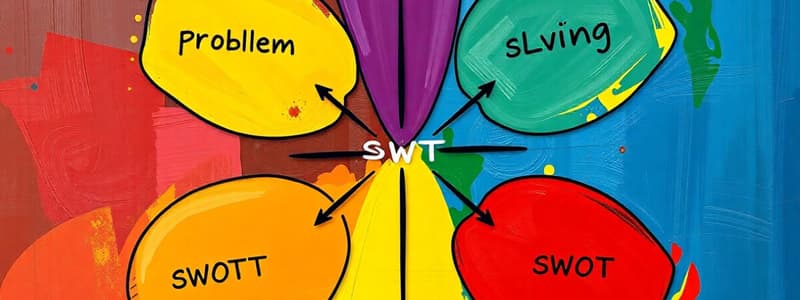Podcast
Questions and Answers
Which problem-solving technique focuses on identifying the fundamental cause of a problem?
Which problem-solving technique focuses on identifying the fundamental cause of a problem?
- Brainstorming
- Root Cause Analysis (correct)
- Trial and Error
- Divide and Conquer
What is a characteristic of heuristics in problem-solving?
What is a characteristic of heuristics in problem-solving?
- They require step-by-step procedures.
- They simplify decision making. (correct)
- They guarantee a solution.
- They are often slower than algorithms.
Which logical fallacy involves misrepresenting someone's argument to refute it more easily?
Which logical fallacy involves misrepresenting someone's argument to refute it more easily?
- Straw Man (correct)
- Post Hoc Ergo Propter Hoc
- Ad Hominem
- Hasty Generalization
What does the False Dichotomy fallacy entail?
What does the False Dichotomy fallacy entail?
Which of the following techniques encourages collaborative and creative thinking by generating numerous ideas?
Which of the following techniques encourages collaborative and creative thinking by generating numerous ideas?
What is a common misconception about algorithms in problem-solving?
What is a common misconception about algorithms in problem-solving?
Which logical fallacy argues that a modest first step will inevitably lead to negative consequences?
Which logical fallacy argues that a modest first step will inevitably lead to negative consequences?
Which of the following techniques breaks down a problem into smaller parts for easier handling?
Which of the following techniques breaks down a problem into smaller parts for easier handling?
Flashcards are hidden until you start studying
Study Notes
Problem-solving Techniques
-
Defining the Problem:
- Clearly identify and articulate the issue at hand.
- Gather relevant information and determine the root cause.
-
Brainstorming:
- Generate a wide range of ideas without immediate judgment.
- Encourage creative thinking and collaboration.
-
Trial and Error:
- Implement potential solutions on a small scale to test their effectiveness.
- Learn from mistakes to refine approaches.
-
Algorithms:
- Step-by-step procedures or formulas used to solve problems systematically.
- Guarantees a solution if followed correctly.
-
Heuristics:
- Rule-of-thumb strategies to simplify decision making.
- Often quicker than algorithms but may not guarantee a solution.
-
Divide and Conquer:
- Break the problem into smaller, manageable parts.
- Solve each part individually before combining results.
-
SWOT Analysis:
- Assess strengths, weaknesses, opportunities, and threats related to a decision or strategy.
-
Root Cause Analysis:
- Identify the fundamental cause of a problem to develop effective solutions.
Logical Fallacies
-
Ad Hominem:
- Attacking the person instead of addressing the argument.
-
Straw Man:
- Misrepresenting or oversimplifying someone’s argument to refute it easily.
-
Appeal to Ignorance:
- Claiming something is true because it has not been proven false, or vice versa.
-
False Dichotomy:
- Presenting two options as the only possibilities when others exist.
-
Slippery Slope:
- Arguing that a small action will lead to significant and adverse consequences without evidence.
-
Circular Reasoning:
- When the conclusion of an argument is included in its premises.
-
Hasty Generalization:
- Making a broad claim based on insufficient evidence or a small sample size.
-
Appeal to Authority:
- Asserting a claim is true because an authority figure endorses it, without considering the evidence.
-
Post Hoc Ergo Propter Hoc:
- Assuming that because one event followed another, the first event caused the second.
Problem-solving Techniques
- Defining the Problem: Clearly define the problem, gather relevant information, and determine the root cause before attempting a solution.
- Brainstorming: Generate a wide range of ideas collaboratively without immediate judgment to find innovative solutions.
- Trial and Error: Test potential solutions on a small scale to assess effectiveness and learn from mistakes through continuous refinement.
- Algorithms: Follow step-by-step procedures or formulas that guarantee solutions if applied correctly.
- Heuristics: Use rule-of-thumb strategies for quicker decision-making although solutions might not be guaranteed.
- Divide and Conquer: Break down complex problems into smaller, manageable parts, solve each independently, and combine the results.
- SWOT Analysis: Conduct a systematic evaluation of Strengths, Weaknesses, Opportunities, and Threats to enhance decision-making and strategy development.
- Root Cause Analysis: Identify the fundamental cause of a problem to develop effective and lasting solutions.
Logical Fallacies
- Ad Hominem: Attacking the person making an argument rather than addressing the argument itself.
- Straw Man: Misrepresenting or oversimplifying someone’s argument to refute it more easily.
- Appeal to Ignorance: Claiming something is true because it hasn’t been proven false (or vice versa), instead of relying on evidence.
- False Dichotomy: Presenting only two options, when in fact, more possibilities exist.
- Slippery Slope: Assuming that a small action will inevitably lead to significant adverse consequences without sufficient evidence.
- Circular Reasoning: Using the conclusion as a premise, creating a circular loop without supporting evidence.
- Hasty Generalization: Making a broad claim based on insufficient evidence or a small sample size.
- Appeal to Authority: Asserting a claim is true because an authority figure endorses it, without considering the evidence.
- Post Hoc Ergo Propter Hoc: Assuming that because one event follows another, the first event caused the second.
Studying That Suits You
Use AI to generate personalized quizzes and flashcards to suit your learning preferences.




